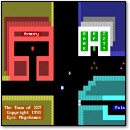VC&G Anthology Interview: What Makes a Video Game? A Short Conversation with Nolan Bushnell (2011)
October 23rd, 2015 by Benj Edwards Back in 2011, I wrote an article about the creation of Nutting Associates’ Computer Space on the occasion of its 40th anniversary. If you’ll recall, Computer Space was the world’s first mass-produced and commercially sold video game. It started the video arcade game industry.
Back in 2011, I wrote an article about the creation of Nutting Associates’ Computer Space on the occasion of its 40th anniversary. If you’ll recall, Computer Space was the world’s first mass-produced and commercially sold video game. It started the video arcade game industry.
While researching the piece, I conducted extensive telephone interviews with Ted Dabney and Nolan Bushnell, the co-creators of the game (who went on to become the co-founders of Atari). During my conversation with Bushnell, we touched upon some other topics too — when you have a guy like Bushnell on the phone, you tend to ask whatever you need when you have the chance.
 While looking through the transcript of that 2011 interview again recently, I came across a section near the end where Nolan and I talked about what it really means to be a video game. During our conversation, Nolan hit on something that I think is rather profound, yet completely obvious in hindsight. I thought other folks might find our conversation, and its resulting conclusion, interesting.
While looking through the transcript of that 2011 interview again recently, I came across a section near the end where Nolan and I talked about what it really means to be a video game. During our conversation, Nolan hit on something that I think is rather profound, yet completely obvious in hindsight. I thought other folks might find our conversation, and its resulting conclusion, interesting.
I’ve kept this transcript nearly verbatim because I feel it reflects the spontaneous, free-flowing nature of the conversation. We were talking as he was driving home from a business appointment, so he was slightly distracted at the time.

Benj: I have this issue about what is a video game and what isn’t a video game. When I look back through how we commonly classify history, there are computer games and video games, and people tend to segregate them. What do you think about combining them together?
For example, you said you wrote computer games on a PDP-1 that were essentially video games [We discussed this earlier in the interview — Ed.], because they used a visual display. What’s the fundamental difference between the two — or is there one?
Nolan: I don’t think there is one. I think a game on a screen..I mean, ’cause if you want to get technical, you can say, “What’s the difference between raster scan and vector graphics?”
You know, Tempest was a vector graphics game, Lunar Lander was a vector graphics game. But they were clearly all video games, and we just basically learned how to do certain kinds of technologies cheap enough to commercialize them. So I think it’s an arbitrary distinction that doesn’t really matter in the whole scope of things.
Benj: So you could just call them all “electronic games.”
Nolan: No, I think you have to have a “video” in there. Because…
Benj: It has a cathode ray tube of some kind?
Nolan: Right. Even then, all of a sudden, the distinction goes away because of LCD TVs these days.
Benj: That just makes it more complicated.
Nolan: So I think that the idea that there’s an image that can move and is run by some kind of an electronic construct. That’s really the definition.
Benj: Would you consider an electronic checkers game that had an image, say, from the 1960s — if you had made it on a visual screen — to be a video game?
Nolan: Oh yeah. Remember, we had a Chess cartridge for the 2600.
Benj: But what if it were text? What about text-based games for mainframes? Is there a line there, where they’re not video games because they’re not graphical, necessarily?
Nolan: That’s an interesting question. That’s probably a meaningful distinction. ‘Cause clearly, you could use that on a paper output just as effectively.
Benj: Yeah, that’s true. You’re absolutely right about that — paper. That’s where it got started too. They were using paper teletypes.
Nolan: Oh yeah. Text adventure games were in the old days of when we were doing 300 baud modems and time-sharing. [laughs]
Benj: [chuckles] The good old days.
Nolan: [chuckles] Well…not so good.

So What Is A Video Game, Then?
 This conversation may not tell us exactly what a video game is (that’s an ongoing, nebulous definition that I address more below), but we can add to the list of what a video game is not: If an electronic game can be played via a teletype or line printer display (i.e. Zork, TradeWars 2002), it is not a video game. Why? Because the game does not require a video display to function.
This conversation may not tell us exactly what a video game is (that’s an ongoing, nebulous definition that I address more below), but we can add to the list of what a video game is not: If an electronic game can be played via a teletype or line printer display (i.e. Zork, TradeWars 2002), it is not a video game. Why? Because the game does not require a video display to function.
The illustrations for games like that, described in text, are rendered in your mind and not on a screen.
Video displays are characterized by fast refresh rates and their ability to display dynamic, arbitrary, moving images. While originally referring to a raster-scan CRT display, the term “video” as used in the term “video game” has grown to encompass almost any electronic display that can display arbitrary illustrations.
But wait — does a video game display have to be purely electronic? Let’s do a thought experiment.
What if you had a 128×128 grid of tiles, controlled by a computer, that mechanically flipped from black to white, much like computer pixels, depending on game play? On such a screen, if it refreshed quickly enough, you could play an arbitary bitmapped game such as Tetris or Breakout. Would that be a video game?
 Now think about Building Tetris, which uses lights turning on and off within skyscraper rooms dynamically in a pseudo-bitmap fashion. Is that a video game?
Now think about Building Tetris, which uses lights turning on and off within skyscraper rooms dynamically in a pseudo-bitmap fashion. Is that a video game?
By our modern definition, which transcends raster-scan CRTs to include all displays capable of producing arbitrary illustrations, I’d say yes.
How about Tiger handheld LCD games, which used predefined LCD illustration elements and could not generate arbitrary illustrations? I would say that they were electronic games, but not video games.
Now let’s revisit the teletype/printer with another thought experiment. If you had a printer that printed and spit out paper fast enough to create a 30 FPS animated stop-motion effect, could you play a video game on it? Since it could produce arbitrary, moving illustrations, I’d say yes.
Things are always weird when you think about them hard enough. And perhaps I am overthinking it. But It’s my job to think about these things. I just don’t typically do it out loud.
So based on that conversation with Bushnell — and everything I’ve ever learned while writing about video game history over the past decade — here’s my current working definition of a video game in the modern era:
video game (n) – A game using electronic logic that must be played through a display capable of generating arbitrary moving images
(Note that I’m saying “electronic logic” — not necessarily digital or computer logic — so early non-computer arcade games and the Magnavox Odyssey still count.)
Honestly, you could parse the definition of “video game” forever. For example: What is a game? What consists of an “image” or “illustration”? What does “arbitrary” or “logic” really mean?
I don’t know why I’m writing all this, because I don’t feel like arguing about it. But I will admit that this definition is still a work in progress. So if you’d like to speculate more about the definition of “video game” in the comments, be my guest. I can’t promise that I will debate anyone about it, though.






October 26th, 2015 at 10:55 am
I think “electronic logic” is the key. The display can vary. The future games that will be projected into our brains will probably still be run on some computer or electronic system.